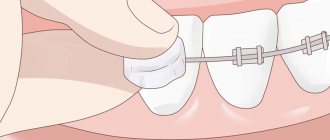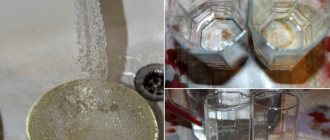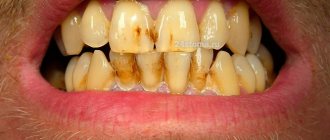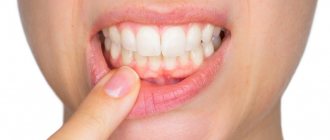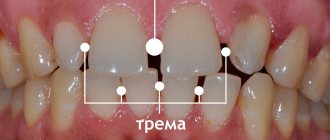Installing crowns is one of the most effective ways to restore teeth. How can you determine that the prosthesis is of adequate quality and that the fixation procedure was carried out according to all the rules? It’s very simple: artificial teeth should not be visually different from real teeth. By and large, such a result can only be achieved if two conditions are met: the doctor installing ceramic crowns must be a true professional, and the structure itself is made of solid ceramics. Andrey Nikolaevich Karneev, leading orthopedist at the German Implantology Center, spoke about what a ceramic crown on a tooth is.
What are the advantages of a ceramic crown?
Today, ceramic dental crowns are the most aesthetically pleasing orthopedic structures installed both in the smile area and on chewing teeth. Ceramics is biologically inert and indifferent, is not perceived by the body as something foreign, does not absorb foreign odors, pigments and bacteria, does not emit harmful substances, and is also very durable. High-quality dentures cannot be distinguished from natural teeth.
3 main advantages of ceramic crowns
- Superior Aesthetics
- Hypoallergenic
- Reliability
What types of ceramic crowns are there?
Pressed ceramic crown
The most advanced type is the pressed ceramic crown. The design is highly durable, more accurately reproduces the color of natural teeth, and to install the prosthesis there is no need for strong grinding of the teeth, as is required for fixing structures made from other materials. The last advantage is extremely important, since the service life of the prosthesis depends on the amount of preserved natural dental tissue.
The most famous types of dentures made of pressed ceramics are created using E-max and Empress technologies.
- The E-max ceramic crown is made of lithium disilicate, that is, glass ceramics, which has a high degree of strength and is ideal for prosthetics in both the anterior and chewing regions.
- The Empress ceramic crown is made from the same material, but with the addition of leucite crystals, a mineral of igneous origin. The structures have excellent aesthetic characteristics, but are not able to withstand heavy loads, so they are installed only in the smile area.
Ceramic zirconium crowns
Often, prostheses made of zirconium are classified as metal-free ceramic crowns, which is fundamentally incorrect. Zirconium dioxide is the same metal, only white. Unlike ceramics, it does not have sufficient transparency, and its color palette is very limited. But, on the other hand, this material has good strength. Which crowns are better – ceramic or zirconium? Zirconium dioxide ceramic crowns are more suitable for restoring chewing teeth. In the frontal section, preference should be given to designs made of metal-free ceramics.
Ceramic crowns on a zirconium dioxide frame
A crown on a zirconium base, coated with a layer of ceramics, is the latest development in prosthetics. The white material, unlike metal, does not shine through the porcelain shell, which allows you to achieve excellent aesthetic results with high strength and wear resistance of the structure. In addition, the biocompatibility of a ceramic crown on a zirconium frame eliminates the risk of allergies and periodontal inflammation.
Reasons for failure when applying ceramic coatingsFounder's view
A.D. Skokov, Candidate of Technical Sciences, MoscowCurrently, domestic dentistry is developing in the direction of intensive use of metal-ceramic technologies. And every dental technician, in order to be fluent in the technology of applying ceramic coatings, must know the specific physical properties of the dental alloys and ceramic masses used. Since failure to comply with certain operating rules for manufacturing a metal frame and applying a metal-ceramic coating sometimes leads to undesirable results.
This article is devoted to the problems of gross violations
technologies when using nickel-chromium-molybdenum and cobalt-chromium-molybdenum alloys, and aims to explain the reasons for the appearance of cracks and the green tint of metal-ceramic prostheses, and give recommendations for their prevention.
Ceramic coating “CRACKING”
The likelihood of such undesirable phenomena occurring can be minimized by a specialist who is familiar with the physical properties of the materials he uses in his work and is able to take into account such an important factor as CTLR
.
Metal-ceramic structures use two materials that are dissimilar in their properties: metal and ceramics. Metal is ductile, has high strength, and allows any stress pattern: compressive and tensile. Ceramics are fragile and can only work under compression. With the slightest bending or tensile forces it collapses. To prevent this from happening, to reduce the internal thermal stresses that arise during the formation of transition layers, certain conditions are imposed on the physical properties of both metal and ceramics.
In practice, it was established that the material of the metal frame must have a coefficient of thermal linear expansion ( CTLE
) in the temperature range from 20 to 600°C is approximately 0.3 x 10-6 more than ceramics.
Such a difference in the CTLR
of materials leads to the fact that when cooled from high temperatures,
the frame alloy reduces its linear dimensions faster
than
the ceramic coating
, which for this reason is subject to compression.
In the case of uniform cooling of the matched metal-ceramic structure,
the temperature of the metal frame is slightly higher than the temperature of the ceramic coating, and the magnitude of the resulting compressive stresses on the ceramic layer is small and
amounts to 2–5 kg/ mm2
.
In case of uneven or rapid cooling, this value can increase by 10 - 100 times and the ceramic coating may be destroyed
. For example, during rapid cooling in a flow of cold air from a fan or in water.
If the resulting stresses do not exceed the strength limit of the ceramic layer, then destruction does not occur. But the ceramic layer remains compressed
and at room temperature.
And subsequently, these compressive forces
applied to the ceramic coating from the metal frame
compensate for the tensile stresses applied to the ceramic layer
during subsequent heating. For example, when the denture is reheated during the application of the dentin or glaze layer, or in the case of a finished denture, when the patient drinks hot tea.
The linear expansion coefficient in the temperature range from 20 to 600°C for cobalt-chromium-molybdenum alloys ranges from 14.3 x 10-6 to 14.5 x 10-6, and for nickel-chromium-molybdenum alloys from 13.9 x 10-6 to 14.2 x 10-6. For these groups of alloys, two groups of ceramic masses have been developed. For example, the company IVOCLAR
IPS
ceramics for working with nickel-chrome and
HPS
for working with cobalt-chrome alloys, respectively.
If, contrary to recommendations, you use HPS
IPS
ceramics for cobalt-chrome alloys, then with increasing cooling rate after annealing, the likelihood of cracking of the coating increases. With slow cooling, cracking may not occur immediately, which does not exclude the appearance of this defect later.
If all conditions for applying a ceramic coating are met and the heating and cooling processes of the prosthesis in a ceramic oven are carried out at a deliberately low speed, the ceramic coating cracks. It does not matter when this destruction occurs: during the manufacturing process - during annealing, or immediately after annealing, or during the finishing process of the finished prosthesis, - or in the patient’s mouth; always, in all cases, the cause of this defect is a discrepancy between the CTLR of the alloy and the ceramic coating.
There are few options for technological errors:
1. Incompatibility of KTLR alloy and ceramics
– wrong choice of alloy. Be careful when choosing an alloy and ceramics!
2. Use of foundry waste of another, often iron-containing alloy
.
For example, residues from a previous stainless steel melt. The presence of iron in the alloy enhances the paramagnetism of the alloy (nickel-chrome alloys are not ferromagnetic) and the phenomenon of magnetostriction, thereby sharply increasing the CTLR
of the alloy. In all technical conditions for the production of nickel-chrome alloys for metal-ceramic work, the chemical composition of the alloys does not allow the iron content to exceed 1–2%!
3. Repeated attempts to melt the metal; or increasing the time the metal remains in the molten state
; (recommended maximum melting time is 90–120 seconds). Here it is appropriate to recommend that during any smelting, foundry workers should melt quickly, at maximum power, but not overheat the metal. Since even in the process of vacuum smelting, at high temperatures, the alloy is always contaminated with oxides and, as a result, its properties deteriorate.
Ceramic coating turns green
This phenomenon primarily applies to nickel-chrome alloys. All nickel-chrome alloys used in dentistry for metal-ceramic work are created on the basis of heat-resistant resistance alloys, originally intended for heating elements of furnaces, electric stoves, etc. These are the so-called “NICHROMS”. Their high corrosion resistance is due to the fact that at high temperatures a strong oxide film consisting of NiO(8%) and Cr2O3(90%) oxides is formed on the surface of the nickel-chrome alloy. The technological process of applying a ceramic coating includes the stage of preliminary oxidation in a vacuum. It is then that this film is formed. Initially, it is very thin (10-6–10-5 mm) and performs a useful function as an intermediate adhesive layer for ceramic primer. In such thicknesses it has a matte gray graphite color
.
But if the oxidation process occurs in air or in an insufficiently high vacuum, or at elevated temperatures and for an excessively long time (the pressure in the oven is above 60 mbar, the oxidation temperature is above 980 ° C, and the time spent at high temperature is more than 10 minutes), then this film , thickening, acquires a greenish tint
, the intensity of which increases as the film thickness increases. This is the color of chromium oxide. (Goya paste color - used for polishing dentures, glass and jewelry).
You should also pay attention to the fact that the frame metal has a certain amount of oxygen dissolved in it, usually 0.002–0.005% for vacuum smelting metal and 0.01–0.01% for open smelting metals. And the powder primer itself and powder ceramics contain absorbed oxygen molecules. Therefore, the process of formation of an oxide film occurs not only at the first stage of vacuum annealing of the metal frame, but also during further processes of application and formation of the ceramic coating, both the primer layer and the dentinal layers of ceramics.
We emphasize: thickening of the chromium-containing oxide layer occurs at all stages of ceramic formation.
An undesirable greenish tint to the prosthesis is caused by an excessive thickness of the oxide layer.
Since it activates the diffuse penetration of chromium oxides into the surface layers of ceramics
.
This phenomenon may be partially facilitated by the low quality of casting blanks: an increased amount of gases in the original alloy - open smelting, direct casting of blanks in an air atmosphere, etc. The quality of casting blanks can be judged by their appearance.
| Rice. 1. Casting blanks of cobalt-chrome alloy “DENT-PD 1000 INGOT” with an axial shrinkage cavity from DENTKO INTERPRISES (USA). |
If casting blanks are produced in factories by directly pouring metal in the form of small ingots weighing 7–10 g, then the resulting casting blanks can always have casting defects and an increased gas content. Casting blanks obtained by suction of liquid metal into quartz or metal tubes also have the same defects (Fig. 1).
Poorly deoxidized metal, i.e. with a high content of gases (oxygen), has lower corrosion resistance, and reduced ductility - difficult to deform. Therefore, some guarantee that the metal is well deoxidized and does not contain a large amount of gases is rolled metal with a clean, smooth surface.
Thus, if the finished prosthesis has a greenish tint, then the reason for this clearly lies in the large thickness of the oxide film under the ceramic coating.
To prevent the occurrence of such a phenomenon, we can recommend:
1. Use vacuum melted metal blanks for casting frames.
2. Melt at maximum power without overheating the metal.
3. Do not use foundry waste.
4. Monitor the vacuum system of the ceramic furnace and check for leakage: 40 seconds after turning off the pump, the pressure in the system should not be higher than 70 mbar.
5.
Always maintain normal oven pressure (20–55 mbar)
during all stages of ceramic coating application . Periodically change the oil in the oil vacuum pump. Do not allow “drafts” in the vacuum system of the furnace (it happens that the pressure gauge shows low pressure, but there is air leakage - the rubber gasket in the vacuum furnace is dirty, etc.).
6. Regularly check that the oven thermometer readings are correct.
, using at least the silver test.
7. Adjust the mode of formation of the surface oxide film in the direction of lowering the temperature and reducing the exposure time.
8. Use proven brands of ceramics for ceramic coatings.
9. When applying primer and dentin layers, use freshly prepared solutions
.
Prohibiting the use of foundry waste would be an unaffordable luxury, therefore, in order to save money, it can be recommended to use waste when melting less critical work: single solid crowns or for plastic lining, with a corresponding change in list prices. This will allow the use of foundry waste from both nickel-chrome and cobalt-chrome alloys without any risk of obtaining low-quality products or causing economic damage to the company.
(№ 5 (34) 2002)
Ceramic crowns for front teeth
Many experts believe that ceramic dental crowns can only be used for prosthetics of the front teeth. Meanwhile, new generation pressed ceramics make it possible to make not only highly aesthetic, but also highly durable structures. The absence of a metal frame in such prostheses is not a sign of fragility or unreliability. Ceramic crowns for chewing teeth also have a place in dental practice.
How are ceramic crowns placed?
Installing a ceramic crown involves the following steps.
- Preparation. The patient undergoes a visual examination, X-ray diagnostics, canal treatment and gentle grinding of the tooth - the specialist removes much less dental tissue than for crowns made of other materials. An additional advantage is that removal of the nerve is not a prerequisite for attaching a ceramic prosthesis.
- Making a ceramic crown. The doctor takes impressions of the jaws and sends them, along with x-rays, to the laboratory, where a plaster model is made to create an orthopedic structure using one of two technologies:
- hot pressing with layer-by-layer application of ceramics;
- computer modeling CAD/CAM and milling.
If the tooth tissue is severely damaged and there is no reliable base for the prosthesis, a stump inlay is first placed under a ceramic crown. More recently, under similar circumstances, a ceramic crown was installed on a pin, but today the method is outdated and is practically not used in clinics.
- Fixation of a ceramic crown. The procedure is carried out using a special cement or primer, which is polymerized by light. A ceramic crown, like any other, can be placed correctly only by an experienced orthopedist. Poor quality prosthetics leads to inflammatory processes in the gum tissue, tooth destruction and loss of the structure.
How much does it cost to install a ceramic crown in Moscow clinics?
Prostheses made of ceramics and zirconium dioxide are expensive. Prices for one crown start from 9-10 thousand rubles and reach 50,000 rubles. This difference in cost is explained by:
- various types of materials;
- doctor's qualifications;
- prestige of the clinic;
- experience of a dental technician and laboratory equipment;
- the complexity of manufacturing a particular type of structure.
Below is the average cost for various types of ceramic and zirconium prostheses in Moscow clinics. Prices are indicated on a turnkey basis - including taking impressions, grinding teeth and installing the structure.
However, keep in mind that preparatory procedures (sanitation, depulpation, treatment of inflammatory processes) are paid separately. In addition, some dentists include temporary plastic crowns (800-1,500 rubles) and stump inlays (4,500 - 12,000 rubles) as separate items in their price list.
| Type of prosthesis | Average price in rubles | ||
| Ceramics E-max Empress | Ceramics CAD/CAM | From zirconium dioxide | |
| Lumineer | 35 000 | 45 000 | 37 000 |
| Veneer | 20 000 | 22 000 | 24 000 |
| Crown | 25 000 | 29 000 | 21 000 |
| Tab | 16 000 | 9 000 | 38 000 |
| Repair of chips | from 3 000 | ||
Dentures made of ceramics and zirconium dioxide are the best for restoring severely damaged or lost teeth. However, they cannot be called ideal. There are many nuances in the selection and manufacture of various types of structures. Therefore, check what materials the dentist uses - otherwise the result may disappoint you.
What is the service life of a ceramic crown?
Metal-ceramic crowns are fixed with dental cement, which breaks down after about 5 to 7 years. However, ceramic dentures are attached to a particularly strong adhesive material, which increases their service life to 10 years.
As for strength, ceramic crowns can easily withstand the required chewing load. If a ceramic crown chips for some reason, it can be easily restored. Since the metal-free structure does not have a frame, almost any minor damage to it will be invisible. If more or less serious damage occurs, the all-ceramic crown can simply be polished.
Photos before and after installation of ceramic crowns at the Research Center. Works by Karneev A.N.
Indications and contraindications for installation
Standard indications for the installation of ceramic prostheses:
- extensive non-carious enamel defects (chips, pathological abrasion, wedge-shaped defects) - place lumineers, veneers or crowns;
- tooth decay of 2/3 or more - crowns or inlays are installed;
- slight curvature of the dentition: covered with crowns, less often with veneers;
- the absence of 1 or more teeth is replaced with a bridge.
Which type of prosthesis and from which material is suitable for a particular patient depends on the clinical situation. So, glass ceramics are the best choice for:
- production of veneers and ultra-veneers;
- installing crowns on the front teeth;
- fixation of a 3-unit bridge;
- high transparency of enamel;
- increased aesthetic requirements.
Bruxism is a contraindication to the installation of ceramic dentures, since the dentures will chip
. Zirconium dioxide is suitable in the following cases:
- prosthetics of premolars and molars;
- production of extensive bridges for front or back teeth - from 4 units or more;
- replacement of all crowns in the smile area on the upper and lower jaw;
- with bruxism;
- for prosthetics on implants.
General contraindications to prosthetics are taken into account:
- pregnancy and lactation;
- any diseases (systemic and oral) in the acute stage;
- osteoporosis;
- severe violations of occlusion - open, cross bite.
It is also not recommended to install ceramic dentures on darkened crowns - they will show through. In this case, it is better to cover the teeth with metal ceramics.
In addition, metal-free structures are undesirable in cases of extensive partial edentia (the absence of 3 or more adjacent teeth) - in this case it is better to install implants or removable dentures.
Photos before and after ceramic dentures
Restoration of ceramic crowns
Despite the strength of modern ceramic dentures, the query “The ceramic has broken off from the crown, what should I do?” found on the Internet quite often. Typically a defect occurs for the following reasons:
- injury - blow or fall;
- defects in the work of a dental technician;
- malocclusion, bruxism;
- strong mechanical impact on the structure during chewing.
There are two possible solutions to the problem - replacement and restoration.
- Replacement of prosthesis. The crown is removed from the mouth, and the entire prosthetic process is repeated from the moment the impressions are taken until the new structure is attached.
- Restoration. The chip on the ceramic crown is polished to the optimal shape, and a light-curing composite material is placed into the cavity. After hardening, the specialist models the coating, forms bumps and fissures, and grinds uneven edges to the desired size.
The advantages of repair are short time and low cost; chipped ceramics on the crown can be restored in an hour in the dentist’s chair. However, even the use of the most modern materials does not provide the quality that is obtained when making a prosthesis “from scratch” in a dental laboratory. If the cause of the chip was carelessness when chewing hard food, after repair the denture will last for many years. Malocclusions and other pathologies of the dental system reduce the service life of the restored crown several times.
Working with ceramics on metal frames: possible causes of errors and ways to eliminate them
We all know that the final result of manufacturing metal-ceramic crowns and bridges is influenced by several factors: the furnace, alloy, methods of processing the frame, application of opaque, layering technology, firing temperature, etc. However, it is very often difficult to understand the true cause of cracks, bubbles or chips .
For the convenience of dental technicians, we analyzed various problems when working on ceramics and presented in a convenient form ways to eliminate them. The table presented below will be a good assistant for the technician in his daily work.
Certain issues such as kiln calibration, selection of the correct sintering temperature, application and firing of ceramics have been discussed with illustrations for better clarity and understanding:
1. Oven calibration. The furnace is calibrated using a silver test. It is very important to calibrate your furnace at least once every six months.
Rice. 1. Calibration of the furnace using a silver test
2. Selecting the correct ceramic firing temperature. When choosing the desired firing temperature, first follow the ceramic manufacturer's instructions. Further, if necessary, the temperature should be adjusted based on the results obtained.
If you see that the ceramic has a milky color and the surface is uneven (Fig. 2, crown number 1), then the temperature is too low. Raise the temperature by 10 degrees. If the crown is still cloudy (Fig. 2, crown number 2), then the temperature should be increased by another 10 degrees. The ceramic should shine slightly like crown number 3. If the corners are swollen or the ceramic has become too transparent, the temperature is too high (Fig. 2, crown numbers 4 and 5).
Rice. 2. Appearance of ceramics sintered at different temperatures
3. Application and firing of opaque. At the correct temperature, after the first firing the surface should be as shiny as a crown in the center (Fig. 3).
Rice. 3. Opaquer surface sintered at different temperatures
Examples of incorrect application and firing of opaque:
Rice. 4. Initial sintering temperature is too high
Rice. 5. Drying time is too short
Rice. 6. The opaquer was applied too thickly
4. Problems when firing ceramics. When firing ceramics, you should always remember the compatibility of the CTE of the ceramic and alloy, the initial sintering temperature, the rate of temperature rise, vacuum, final temperature, and drying time. If we set the drying time too short, chips will form on the surface of the ceramic, as in Fig. 7.
Rice. 7. Drying time is too short
If the furnace has a vacuum problem, this will definitely affect the transparency of the sintered ceramic (Fig. 8).
Rice. 8. The left bridge was sintered at normal vacuum, the right at 50%
And a very common cause of chips and cracks is the incompatibility of the CTE of ceramics and alloys (Fig. 9).
Rice. 9. The CTE of the alloy does not correspond to the CTE of ceramics
To ensure that the technician does not have problems working with ceramics, it is necessary to follow several rules: Firstly, it is very important to monitor the condition of your furnace. Contamination of the muffle or malfunction of the vacuum can greatly affect the final result of the work. You should also calibrate your furnace every six months. Secondly, you should always use alloys whose CTE is suitable for the CTE of ceramics. Try to use less recycled metal. Thirdly, always look at the ceramic manufacturers' instructions and strictly follow all the requirements written there. In this case, the final firing temperature can be changed depending on the results obtained. Two ovens from different manufacturers, even after calibration, may have different temperatures inside the chamber (despite the fact that the same temperature will be shown on the screen). The correct sintering temperature is not the one shown on the furnace screen, but the one at which the correct result is obtained. By following these rules, as well as using the table that was presented in this article, you will be less likely to encounter any problems associated with working on cermets.
Article provided
